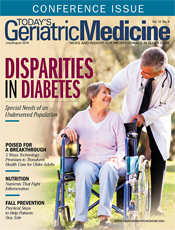
July/August 2019
Poised for a Breakthrough: 5 Ways Technology Promises to Transform Health Care for Older Adults The population demographics of the United States are rapidly changing. Individuals 65 and older currently make up approximately 15% of the growing population, and it’s expected that this number will rise as the baby boomer generation ages. The census bureau states that by 2030, “all baby boomers will be older than age 65. This will expand the size of the older population so that 1 in every 5 residents will be retirement age.” The life expectancy of Americans has greatly increased, adding financial strain on both individuals and the national health care system. Failure to implement the right solutions for elder care may result in a serious public health issue that carries long-term consequences. Advances in technology are poised to transform health care for older adults, with a number of solutions that will improve lives through better care and services. Innovations are being integrated at a rapid pace, and with recent legislative changes, health care institutions are beginning to implement them to help scale their services in emergency departments, hospice care, and rural hospitals. And while telehealth reimbursement still needs significant improvement, 49 states, including Washington, are now willing to reimburse several forms of virtual health care. A few states continue to question the value of certain telehealth technologies, but with the undeniable benefits and cost savings these types of services can offer, it’s just a matter of time before they are adopted by the entire country. Technology is widening the door to a better future, and with the following five innovations, the health care system is set to greatly transform the way we care for today’s aging population. Virtual Assistants While the full integration of telehealth interfaces will take time, existing systems such as Apple’s Siri and Amazon’s Echo are starting the trend. On the horizon are voice recognition platforms that will receive commands, encourage social and physical activity, manage events, and monitor health. Increased success will be highly dependent on the systems’ ability to humanize the process by establishing an emotional connection with patients. Remote Patient Monitoring Telehealth Furthermore, telemedicine allows patients to receive care from specialists who might otherwise be unreachable. Since the elderly are at a higher risk of developing chronic conditions, giving them access to consultations with specialists is absolutely essential. And because virtual care services eliminate the need for travel and shorten consultation times, they can greatly reduce expenses for both patients and health care facilities. Virtual Reality Systems By re-creating connections with visuals, older adults can rekindle forgotten memories, benefit from speech stimulating situations, and receive cognitive therapies in a virtual environment. Additionally, calming imagery can be used to decrease troubling symptoms such as anxiety, agitation, repetitive behaviors, and mood swings. Multiple studies on VR systems treating dementia have reported a remarkable “70% stress reduction in patients,” which can decrease the use of pharmaceutical drugs to control mood swings and other problematic symptoms. Predictive Analytics Ending the constant cycle of hospital admissions and readmissions also limits patients’ long-term exposure to germs and illnesses, helping them achieve better health. Predictive analytics can offer further benefits by unobtrusively recording patient data such as daily routines and activities, including bathroom usage, alerting physicians and health care staff of any abnormalities that can threaten a patient’s well-being, consequently enabling them to take a proactive, rather than a reactive, approach to health care. — Mary Gorder is the founder and CEO of Drs. On Calls, a telemedicine platform that develops, markets, and operates house medical calls, virtual telemedicine service, and concierge medical services. |
